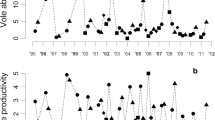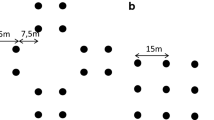Abstract
Rodents that have multi-annual cycles of density are known to have flexible growth strategies, and the “Chitty effect”, whereby adults in the high-density phase of the cycle exhibit larger average body mass than during the low phase, is a well-documented feature of cyclic populations. Despite this, there have been no studies that have repeatedly monitored individual vole growth over time from all phases of a density cycle, in order to evaluate whether such variation in body size is due to differences in juvenile growth rates, differences in growth periods, or differential survival of particularly large or small voles. This study compares growth trajectories from voles during the peak, increase and crash phases of the cycle in order to evaluate whether voles are exhibiting fast or slow growth strategies. We found that although voles reach highest asymptotic weights in the peak phase and lowest asymptotes during the crash, initial growth rates were not significantly different. This suggests that voles attain larger body size during the peak phase as a result of growing for longer.




Similar content being viewed by others
References
Aars J, Ims RA (2002) Intrinsic and climatic determinants of population demography: the winter dynamics of tundra voles. Ecology 83(12):3449–3456
Akaike H (1973) Information theory and an extension of the maximum likelihood principle. In: Petran BN, Csaki F (eds) International Symposium on Information Theory. Akademiai Kiadi, Budapest, pp 267–281
Arendt JD (1997) Adaptive intrinsic growth rates: an integration across taxa. Q Rev Biol 72(2):149–177
Begon M, Telfer S, Burthe S, Lambin X, Smith MJ and Paterson S (2009) Effects of abundance on infection in natural populations: field voles and cowpox virus. Epidemics. doi:10.1016/j.epidem.2008.10.001 (in press)
Blanckenhorn WU (2000) The evolution of body size: what keeps organisms small? Q Rev Biol 75(4):385–407
Boonstra R (1989) Life-history variation in maturation in fluctuating meadow vole populations (Microtus pennsylvanicus). Oikos 54(3):265–274
Boonstra R, Krebs CJ (1979) Viability of large-sized and small-sized adults in fluctuating vole populations. Ecology 60(3):567–573
Boyce CCK, Boyce JL (1988) Population biology of Microtus arvalis. 1. Life-time reproductive success of solitary and grouped breeding females. J Anim Ecol 57:711–722
Case TJ (1978) Evolution and adaptive significance of postnatal-growth rates in terrestrial vertebrates. Q Rev Biol 53(3):243–282
Chitty D (1952) Mortality among voles (Microtus agrestis) at Lake Vyrnwy, Montgomeryshire, in 1936–9. Phil Trans R Soc Lond Ser B 236:505–552
Chitty D (1987) Social and local environments of the vole Microtus townsendii. Can J Zool 65(10):2555–2566
Cuthill I, Houston A (1997) Managing time and energy. In: Krebs J, Davis N (eds) Behavioural ecology: an evolutionary approach. Blackwell, Oxford, pp 97–120
Ergon T, Lambin X, Stenseth NC (2001a) Life-history traits of voles in a fluctuating population respond to the immediate environment. Nature 411(6841):1043–1045
Ergon T, MacKinnon JL, Stenseth NC, Boonstra R, Lambin X (2001b) Mechanisms for delayed density-dependent reproductive traits in field voles, Microtus agrestis: the importance of inherited environmental effects. Oikos 95(2):185–197
Fleming IA (1996) Reproductive strategies of Atlantic salmon: ecology and evolution. Rev Fish Biol Fish 6:379–416
Gaillard JM, Festa-Bianchet M, Delorme D, Jorgenson J (2000) Body mass and individual fitness in female ungulates: bigger is not always better. Proc R Soc Lond B Biol Sci 267(1442):471–477
Hansson L (1995) Size dimorphism in microtine rodent populations: characteristics of growth and selection against large-sized individuals. J Mammal 76:867–872
Huggins R (1989) On the statistical analysis of capture-recapture experiments. Biometrika 76:133–140
Iverson SL, Turner BN (1974) Winter weight dynamics in Microtus pennsylvanicus. Ecology 55(5):1030–1041
Kendall W, Nichols J (1997) Estimating temporary emigration using capture-recapture data with Pollock’s robust design. Ecology 78:563–578
Kimura DK (1980) Likelihood methods for the von Bertalanffy growth curve. Fish Bull 77:765–776
Klemola T, Pettersen T, Stenseth NC (2003) Trophic interactions in population cycles of voles and lemmings: a model-based synthesis. Adv Ecol Res 33:75–160
Koseki Y, Maekawa K (2000) Sexual selection on mature male parr of masu salmon (Oncorhynchus masou): does sneaking behaviour favour small body size and less-developed sexual characters? Behav Ecol Sociobiol 48:211–217
Krebs CJ (1978) Review of the Chitty hypothesis of population regulation. Can J Zool 56(12):2463–2480
Lambin X, Yoccoz NG (2001) Adaptive precocial reproduction in voles: reproductive costs and multivoltine life-history strategies in seasonal environments. J Anim Ecol 70(2):191–200
Lambin X, Petty SJ, MacKinnon JL (2000) Cyclic dynamics in field vole populations and generalist predation. J Anim Ecol 69(1):106–118
Lidicker WZ, Ostfeld RS (1991) Extra-large body size in California voles causes and fitness consequences. Oikos 61(1):108–121
Lima SL (1998) Nonlethal effects in the ecology of predator-prey interactions. Bioscience 48:25–34
Mangel M, Stamps J (2001) Trade-offs between growth and mortality and the maintenance of individual variation in growth. Evol Ecol Res 3:583–593
Mihok S, Turner BN, Iverson SL (1985) The characterization of vole population dynamics. Ecol Monogr 55(4):399–420
Myllymäki A (1977) Demographic mechanisms in the fluctuating populations of the field vole Microtus agrestis. Oikos 29:468–493
Norrdahl K, Korpimäki E (2002) Changes in individual quality during a 3-year population cycle of voles. Oecologia 130(2):239–249
Nylin S, Gotthard K (1998) Plasticity in life-history traits. Annu Rev Entomol 43:63–83
Oli MK (1999) The Chitty effect: a consequence of dynamic energy allocation in a fluctuating environment. Theor Popul Biol 56:293–300
Ostfeld RS, Canham CD, Pugh SR (1993) Intrinsic density-dependent regulation of vole populations. Nature 366:259–261
Pinheiro J, Bates D, Debroy S, Sarkar D (2007) Nlme: linear and nonlinear mixed effects models. R package version 3.1-85
Pledger S (2000) Unified maximum likelihood estimates for closed capture-recapture models using mixtures. Biometrics 56:434–442
Pruitt KM, DeMuth RE, Turner ME (1979) Practical application of generic growth theory and the significance of growth curve parameters. Growth 43:19–35
Ricker WE (1979) Growth rates and models. Fish Physiol 8:679–743
Ricklefs RE (1983) Avian postnatal development. In: Farner DS, King TR, Parkes KC (eds) Avian biology. Academic Press, New York, pp 1–83
Sakamoto Y, Ishiguro M, Kitagawa G (1986) Akaike information criterion statistics. KTK, Tokyo
Stenseth NC (1999) Population cycles in voles and lemmings: density dependence and phase dependence in a stochastic world. Oikos 87(3):427–461
Stenseth NC, Ims RA (1993) Food selection, individual growth and reproduction—an introduction. In: Stenseth NC, Ims RA (eds) The biology of lemmings. The Linnaean Society of London, London, pp 263–280
R Development Core Team (2007) R: A language and environment for statistical computing. R Foundation for Statistical Computing, Vienna. http://www.R-project.org
Turchin P (2003) Evolution in population dynamics. Nature 424(6946):257–258
White G, Burnham K (1999) Program MARK: Survival estimation from populations of marked animals. Bird Study 46(Suppl):120–138
Zullinger EM, Ricklefs RE, Redford KM, Mace GM (1984) Fitting sigmoidal equations to mammalian growth curves. J Mammal 65:607–636
Acknowledgments
This work was funded by the Natural Environmental Research Council (studentship number NER/S/A/2000/03445 awarded to S. Burthe) and the Wellcome Trust (075202/Z/04/Z). The Forestry Commission provided access to sites. Gordon Brown, David Carslake, Jonathan Fairbairn, Stephanie Gebert, Lukasz Lukomski, Matt Oliver, Laura Taylor, Gill Telford, David Tidhar, Rachel Yeates and many others provided fieldwork assistance.
Author information
Authors and Affiliations
Corresponding author
Additional information
Communicated by Peter Banks.
Rights and permissions
About this article
Cite this article
Burthe, S.J., Lambin, X., Telfer, S. et al. Individual growth rates in natural field vole, Microtus agrestis, populations exhibiting cyclic population dynamics. Oecologia 162, 653–661 (2010). https://doi.org/10.1007/s00442-009-1495-6
Received:
Accepted:
Published:
Issue Date:
DOI: https://doi.org/10.1007/s00442-009-1495-6




